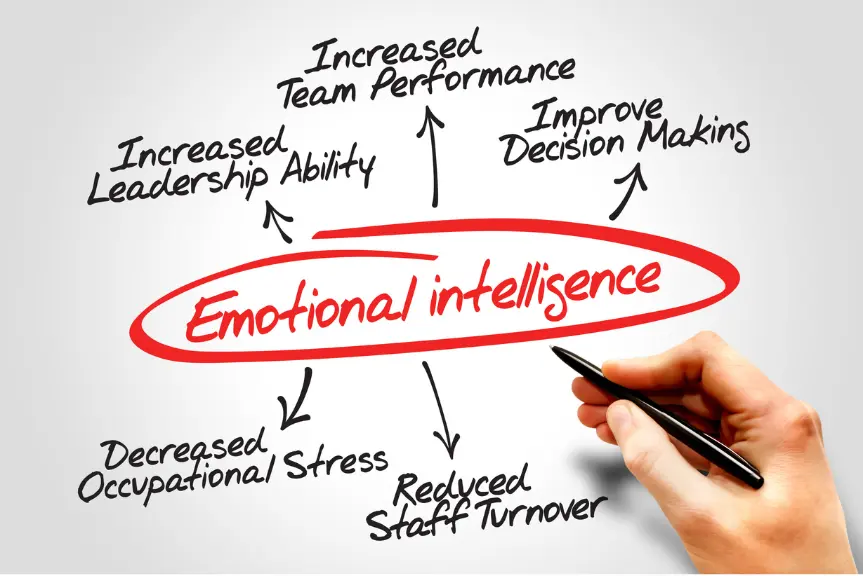What is Emotional Intelligence & How Can You Improve Yours?

- Emotional & Social Intelligence – Definition & Meaning.
- Perceive Emotions
- Understand Emotions
- Influence Emotions
- Use Emotions
- Emotional Intelligence Test.
- Emotional Intelligence Inventory (IE4).
- Mayer-Salovey-Caruso Emotional Intelligence Test (MSCEIT).
- Emotional Competence Inventory (ECI)
- Example
- Conclusion
In the morning, you meet your friends at school. You notice that one of your friends is very taciturn and seems depressed. In a quiet moment, you ask him if he wants to talk about it and if you can help him in any way. So you know how your counterpart feels and can react to it correctly. You have a skill called emotional intelligence.
Emotional & Social Intelligence – Definition & Meaning
Emotional intelligence refers to the ability to perceive one’s own feelings and the feelings of other people, to understand them and thereby to be able to influence and use them.
Emotional intelligence is sometimes seen as contrasting to the well-known concept of intelligence as factual knowledge. As a rule, however, it is about adding another aspect to the classic idea of intelligence.
As early as 1920 Edward Lee Thorndike and David Wechsler dealt with this concept of intelligence under the name “social intelligence”. Emotional intelligence was coined in 1990 by psychologists John Mayer and Peter Salovey. They divided emotional intelligence into four competencies.
- Perceive Emotions
- Understand Emotions
- Influence emotions
- Use emotions
Perceive emotions
In order to be able to respond to emotions, they must first be perceived. This includes the correct interpretation of gestures and facial expressions. When you have toperceptionof emotions are consciously paid attention to the inside.
Understand Emotions
Emotions are triggered by different situations. Feelings must therefore also be correctly interpreted in relation to a specific situation. Also the assessment of whether the emotions of the other person, triggered by oneself or others, is part of emotional intelligence.
Influence Emotions
If emotions are perceived and understood, there is an opportunity to influence them. This applies to both your own feelings and the emotions of other people. The so-called self-regulation.
Use Emotions
Emotions can not only be influenced, they can also be used. By understanding one’s own emotions, one can deduce how another person can best be helped in a certain situation and what needs to be taken into account when dealing with other people for good cooperation in general. Emotions can also be used to achieve other goals
Emotional intelligence test
Emotional intelligence is difficult to measure because your own perception and the personal assessment of people must be determined. Nevertheless, it is possible to measure emotional intelligence using various tests. Three possible tests are the Emotional Intelligence Inventory, the Mayer-Salovey-Caruso Test, and the Emotional Competence Inventory.
Emotional Intelligence Inventory (IE4)
The Emotional Intelligence Inventory (IE4) is used particularly frequently in Germany when emotional intelligence is to be measured. The test of Dr. Lars Satow was designed to identify four domains of emotional intelligence
- Empathy
- Knowledge of human nature
- Emotional self-control
- Power of persuasion
These four factors are determined through self-description, which should refer to one’s own behavior.
Mayer-Salovey-Caruso Emotional Intelligence Test (MSCEIT)
In English-speaking countries, the MSCEIT by Mayer and Salovey is often used and it is also one of the most commonly used tests for determining emotional intelligence worldwide. More than 100 tasks are set, the structure of which is reminiscent of classic intelligence tests and divided into four areas.
- Emotion perception
- Emotion use
- Understanding of emotions
- Emotion influencing
To obtain information about these four points, it is determined whether a person’s emotions can see in the face and knows when emotions can change.
In addition, it is examined whether measures are mastered in order to influence one’s own emotions. The results of this test are then automatically carried out by an evaluation program and finally issued to the participants as a report.
Emotional Competence Inventory (ECI)
Another common test is the Emotional Competence Inventory (ECI). This test by David Goleman is more similar to personality tests. Statements are made such as “I understand how others think” and “I can motivate myself”. The participant must agree or disagree with these statements. This self-assessment is usually followed by an external assessment. Colleagues or other well-known people are used for this. Different areas of the emotional intelligence are considered:
- Self-consciousness
- Self-motivation
- Self-control
- Teamwork
- Empathy
The proof of emotional intelligence through tests makes it possible to perceive this social competence more consciously. Training also makes it possible to train emotional intelligence.
Train Emotional Intelligence
People who have a high level of emotional intelligence are said to be particularly successful at work and in everyday life. Because of this, many want to train their emotional intelligence. Emotional intelligence is innate and develops over the years of childhood, but it is possible to train them, as some research has already established. However, there are still no studies of sufficient size to be able to make general statements.
Self-tests help to clarify the extent to which a person is aware of their own feelings and emotions others are aware of and how much attention is paid to it.
An important point to training emotional intelligence is to target emotions to respect. Anyone who perceives their own feelings recognizes them more easily in others. Reading books or joining a theater group can also help.
Emotional intelligence plays an important role in all areas of life. As already mentioned, the importance of emotional intelligence is not only evident in everyday life, but also at work. So that you can internalize and understand what has already been explained, emotional intelligence will be examined again in more detail using an example in the context of the work
Example
Suresh is the manager of 45 employees. He notices that the workforce in a department has been creating less work for some time and that it is often of poorer quality. That’s why he’s holding personal talks with the five people in charge to find out where this change is coming from.
He learns that Ragul in particular is often late and that his bad mood has a negative impact on the atmosphere in the office. Instead of simply firing Ragul, Martin shows emotional intelligence and asks if Ragul would like to talk about personal problems and if the company can help, for example by adjusting his working hours.
Ragul accepts the help and can be like that stress minimizes. As a result, he is in a better mood again and no longer negatively influences his colleagues. Instead, he is very grateful to his manager, which is why he even improves his work performance.
Conclusion
How would you rate yourself? Do you have a high level of emotional intelligence or do you still need to practice something to understand your feelings and those of those around you? No matter how you assess yourself since you have now become more familiar with the concept of emotional intelligence, you are already on the right track.

